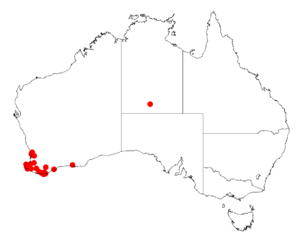Acacia tetragonocarpa facts for kids
Quick facts for kids Acacia tetragonocarpa |
|
|---|---|
| Scientific classification | |
| Genus: |
Acacia
|
| Species: |
tetragonocarpa
|
 |
|
| Occurrence data from AVH | |
Acacia tetragonocarpa is a type of shrub that belongs to the Acacia family, also known as wattles. This plant is found naturally in the South West part of Western Australia.
What Does Acacia tetragonocarpa Look Like?
This shrub can grow in different ways. It might spread out low to the ground (prostrate), grow loosely (straggling), or stand up straight and thin (erect and slender). It often looks a bit like a rush plant. It usually grows to be about 0.05 to 0.5 metres (0.16 to 1.64 ft) tall, but some can reach up to 1.5 m (5 ft).
Its branches are thin and tough, like wire. They have fine yellow lines running along them. The plant's "leaves" are actually special flattened stems called phyllodes. These phyllodes are thin, flat, and shaped like small triangles, only about 1.5 to 3 millimetres (0.06 to 0.12 in) long. Sometimes, you might see regular fern-like leaves (bipinnate leaves) at the very bottom of the stems.
Acacia tetragonocarpa blooms with yellow flowers between March and June, or sometimes in October and November. Its simple flower clusters (inflorescences) usually have two flowers, but can have one to four. The petals have fine fan-like stripes.
After the flowers, reddish-brown, smooth seed pods grow. These pods are slightly curved and are about 2 to 6 centimetres (0.8 to 2.4 in) long and 4 to 5 mm (0.16 to 0.20 in) wide. They have winged edges that are 1 to 2 mm (0.04 to 0.08 in) wide. Inside the pods, the seeds are shaped like cones and are about 5 mm (0.20 in) long. They are arranged lengthwise in the pod.
How Was Acacia tetragonocarpa Named?
This plant was first officially described by a botanist named Carl Meissner in 1844. He included it in a scientific book called Leguminosae. Plantae Preissianae, which was part of Johann Georg Christian Lehmann's work.
Later, in 2003, another botanist named Leslie Pedley changed its name to Racosperma tetragonocarpum. But then, in 2006, it was put back into the Acacia group (genus) again.
The very first sample of this plant used for its scientific description (called the type specimen) was collected near Strawberry Hill Farm in Albany.
Acacia tetragonocarpa is very similar to another plant called Acacia cummingiana, which grows further north.
Where Does Acacia tetragonocarpa Grow?
This plant is found in different places, not all connected, across Western Australia. You can find it as far north as Perth. From there, it spreads south through the Peel, South West, and Great Southern regions. It reaches as far south as Albany and as far east as Tambellup.
It likes to grow in wet areas like swamps, along the edges of small streams (creeklines), and on rocky hillsides. The soil it prefers is usually damp and sandy or loamy. It can also grow in gravelly soils that are rich in iron (lateritic soils).
You often find Acacia tetragonocarpa growing underneath taller trees in forests. It's commonly seen in areas with Paperbark or Jarrah trees. It can also be found in areas of heath land that are growing back after being disturbed.

